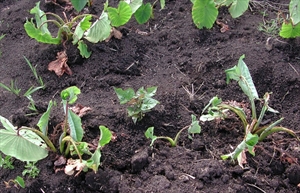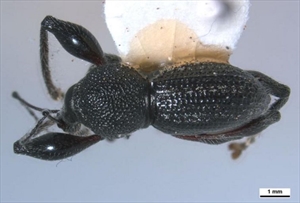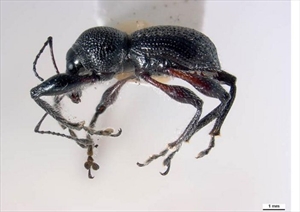Grey weevils, oribius weevils
Pacific Pests, Pathogens, Weeds & Pesticides - Online edition
Pacific Pests, Pathogens, Weeds & Pesticides
Oribius weevils (273)
Oribius species. Note that there are more than 50 species, of which seven are crop pests. Oribius inimicus and Oribius destructor are the two most common and damaging grey weevils of crops in the highlands of Papua New Guinea.
These weevils are recorded only from the island of New Guinea (Papua New Guinea), and northern Cape York, Australia. They occur in both lowlands and highlands, in cropping areas and forests.
More than 40 crops are hosts in the highlands of Papua New Guinea, with major damage reported from apple, avocado, bele (aibeka), capsicum, citrus, coffee, French bean, Irish potato, lettuce, orange, peanuts, strawberry, and taro. Within each crop there are large differences in the damage to individual plants. Of interest, are the high levels of grey weevil infestation on pepino (Solanum muricatum), and the weed thickhead (Crassocephalum crepidioides). On thickhead, adults and larvae feed on foliage and roots, respectively.
The adults do most damage (Photos 1&2). Damage has been reported on important crops, including avocado (shot-hole of leaves, and scaring of fruit), capsicum (fruit damage), citrus (destruction of leaves, consumption of flower buds, and surface scaring of fruit), Irish potato (leaf and root damage leading to yield reduction), and strawberry (foliage and fruit destroyed). For citrus, the destruction of new leaves, green shoots and soft bark, leads to branch die-back, and neglected orange trees are killed. Similar effects occur on apple trees.
Eggs are laid in the soil at the base of plant stems, and the larvae feed on the roots. The length of the larval and pupal stages is not known exactly, but it is thought that the life cycle is about 7 months, with the adults living for more than 6 months.
Adult grey weevils are dark brown, dark grey or black, 4-7 mm long (Photos 3-6). They move to the upper plant canopy early in the morning and, to a lesser extent, again late in the afternoon. Between these times they remain within the canopy, move towards the base of the plant or, possibly, move off the plant. They also move frequently between plants, probably at night.
Infestations of crops come from eggs and larvae remaining in fallow land before it is cleared for cultivation, or from adults migrating from nearby weeds. Grey weevils do not fly, but they are highly mobile and quickly re-infest crops where short-term insecticides have been used. In the highlands of Papua New Guinea, grey weevils are present throughout the year, but are highest during the rainy season, November to April.
Grey weevils lower crop yields, reduce market prices and, in severe cases, kill trees and seedlings. Average losses on a range of vegetables in the highlands of Papua New Guinea has been estimated to be 30-40%.
Exclusion trials in Papua New Guinea have shown the impact of the weevils on avocado, capsicum and strawberry by increasing marketable fruit by over 200%, even though they only kept out half the number of weevils compared to unprotected controls. In citrus, which is highly susceptible, fruit yield on protected plants was 1800% higher than on those unprotected!
Look for the grey to dark brown weevils, 4-7 mm long, in the canopy of crops often on the top of leaves.
CULTURAL CONTROL
Before planting:
- Avoid planting in land where previous crops were infested with grey weevils as it is likely eggs and larvae remain in the soil. Plant with a crop that is not attacked by the grey weevil or suffers only minor damage.
- Do not plant crops susceptible to grey weevils next to older weevil-infested crops, otherwise the weevils will quickly infest the new plantings, and the damage will be greater or more insecticides will be needed to bring the infestation under control.
During growth:
- Weed around the crops as well as within them. In particular, remove the weed known as 'thickhead' from gardens wherever possible because it will attract beetles (Photo 7). It is a major host of grey weevils.
- Use non-preferred plants, such as spring onion, carrot and asparagus, as intercrops and border plants. These act as barriers, protecting crops that are susceptible to grey weevil infestations.
RESISTANT VARIETIES
No varieties are known to be resistant among the crops that are hosts of grey weevils; however, spring onion, carrot and asparagus are rarely damaged, and cabbage suffers very minor damage.
CHEMICAL CONTROL
- Use either sprays of lambda-cyhalothrin or one containing both permethrin and pirimiphos-methyl. Both are effective against grey weevils when used at one quarter of the manufacturers' recommended concentration.
- These chemicals give best control if sprayed directly on the grey weevils. Therefore, apply in the morning (before 10 am) or mid-afternoon as beetles are on plants at this time. During the middle of the day they rest in protected areas off the crop. (Note, early morning spraying during the peak flowering period of a crop should be restricted as pollinators are also commonly active at this time.)
____________________
When using a pesticide, always wear protective clothing and follow the instructions on the product label, such as dosage, timing of application, and pre-harvest interval. Recommendations will vary with the crop and system of cultivation. Expert advice on the most appropriate pesticides to use should always be sought from local agricultural authorities.
AUTHOR Grahame Jackson
Information from Wesis P, et al. (2010) Host use and crop impacts of Oribius Marshall species (Coleoptera: Curculionidae) in Eastern Highlands Province, Papua New Guinea. Bulletin of Entomological Research 100: 133-143. (https://www.researchgate.net/publication/24277626_Host_use_and_crop_impacts_of_Oribius_Marshall_species_Coleoptera_Curculionidae_in_Eastern_Highlands_Province_Papua_New_Guinea; and from Ero M, et al. (2007). Impact and management of Oribius weevils in Papua New Guinea. National Agricultural Research Institute. NARI Technical Bulletin, No. 19. Photos 3-6 Walker K (2006) Oribius weevil (Oribius inimicus and Oribius destructor: PaDIL - http://www.padil.gov.au. Photo 7 Thickhead, Crassocephalum crepidioides. Brisbane City Council weed identification tool. (http://weeds.brisbane.qld.gov.au/weeds/thickhead).
Produced with support from the Australian Centre for International Agricultural Research under project PC/2010/090: Strengthening integrated crop management research in the Pacific Islands in support of sustainable intensification of high-value crop production, implemented by the University of Queensland and the Secretariat of the Pacific Community.










